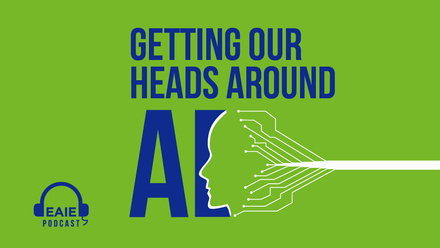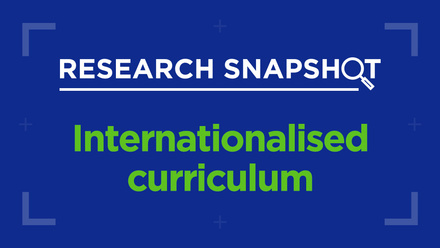How AI is shaking up higher education

Artificial Intelligence (AI) refers to computers performing tasks that would normally require human intelligence to perform. That doesn’t mean there’s an app to persuade a reluctant student to enrol (yet), but what it does mean is a world of opportunity for higher education institutions to become more efficient, more effective and to offer deeper learning experiences.
HEIs are increasingly using AI to streamline processes, personalise learning environments, reach new markets in innovative ways, and generally up their game to meet a new generation of digital natives knocking at their (virtual) door. What follows are some examples of current developments in AI technology and how these are shaking up the (international) higher education sector.
AI opportunities in international higher education
In a nutshell, AI does the heavy lifting that frees up our time to do less onerous tasks, as well as personalising processes for students.
Chatbots, for example, can answer the bombardment of routine questions about scheduling, exam dates and admissions requirements, flagging and filtering the messages that need more personalised attention. Staffordshire University, for instance, has seen great success in the use of its Beacon chatbot, which provides round-the-clock support to students. This is especially useful with the increase in online learning, with students spread across so many time zones.
Virtual teaching assistants and adaptive learning programmes mean that students get personalised pace and direction in their independent study, which is more dynamic and also more inclusive. At the point that students decide they require some one-on-one with the ‘real’ educator, their questions are more targeted, refined and less time-consuming to address.
In a nutshell, AI does the heavy lifting that frees up our time to do less onerous tasks, as well as personalising processes for students.
AI pays dividends in student recruitment and retention too. When a university wants to know why only 12% of applicants actually enrol, AI can collect and interpret big data trends across multiple international markets and conversion points to provide these insights so that processes can be improved. Nova Southeastern University in the USA dramatically improved its retention rates by building AI insights to flag potential leavers and act responsively, another example of AI improving the personal side of education.
The University of Sydney used all of these approaches in a broad AI strategy and reported vastly improved experiences of both service and learning for prospective and current students, as well as for the staff involved.
AI isn’t always ideal – how to choose wisely
What problems are we looking to solve, or what opportunities do we want to create? Where are we wasting time, or making blind decisions? How can we support this new technology to make sure it works well within our institution? These are all questions that should be asked when investigating new technology, in order to avoid being blinded by the sensationalism of the marketing pitch.
Apps and programmes that are AI-driven are not an instant cure, but tools that need to be used consciously and with careful planning for integration. As with many new technologies, there are ethical pitfalls to consider, and there is no such thing as an off-the-shelf solution.
AI-driven apps and programmes are not an instant cure, but tools that need to be used consciously and with careful planning
With the increasing use of AI in higher education, there is a growing concern about the protection of student data. This is because AI algorithms collect and analyse vast amounts of student data, which may include personal information, academic performance and other sensitive data. The University of Plymouth, for example, is currently trialling an AI-driven app which could support students with mental health issues. This is very sensitive data indeed; a breach in such data could result in loss of trust by students and staff and potentially large fines. In fact, AI itself can even be used to hack secure systems.
Another ethical challenge is the potential impact of AI on employment in higher education. AI has the potential to automate many tasks, including grading, administration and even aspects of teaching, and there is much concern about the resulting impact on student well-being from less human interaction. Collaboration between AI and humans is thus important: technology should serve society through feedback from humans to machines and aligning values.
Change is not always within our control
As with most disruptive technologies, AI and its impact is beyond the control of higher education or any other single sector. As a recent example, ChatGPT is a tool making headlines right now, and serves as a perfect example of how open-source tech is going to shape a new paradigm of education, whether or not we are on board. With a freely-available tool like this which can now write passable essays and research papers (or at least the first draft anyway!), the call for more dynamic assessment methods is becoming a clamour. I actually used ChatGPT to write this article… just kidding – but you’re not 100% sure, are you? You may have to use an integrity bot to check.
What is clear here is that we have to rethink the way we assess in response. In this way, and many others, AI is actually influencing change in education, one line of code at a time. You can use ChatGPT to create quizzes, check code, do market research, prompt art, write tasks, improve style or grammar, and so many other things. My hope is that a thorough analysis of the tool will likely result in greater uptake of its use by educators, rather than fearing it. If a chatbot can submit an essay that passes the test, then what does that say about the test, and indeed the way we assess students in general?
Education marketers are also seeing ChatGPT as an opportunity to improve SEO, write social media copy, and even conduct market research. Change is coming.
An eye on the future
With AI use in higher education set to grow by 40% between 2021 and 2027, we are posed a question: what is the cost and consequence of not using AI to expand our offering to students?
Is it fair to assume that the university which offers customised and personalised recruitment processes and digital learning environments, efficient and streamlined time with academic staff, proactive retention strategies backed by data, and intelligent, and data-driven marketing, will have a better chance of surviving the countless threats to our sector? I think that's a given. That's why HEIs need to make themselves aware of developments like those mentioned here and stay on top of the ever-evolving world of AI in higher education. Keep an eye on OpenAI's updates of ChatGPT (text-based AI), DALL-E (image-based AI) and Whisper (voice-based AI) to monitor the future of AI.






